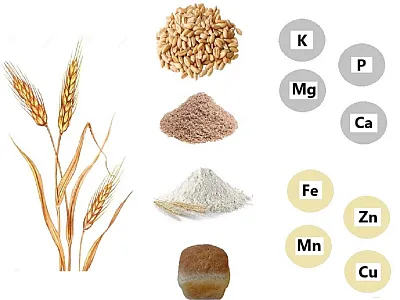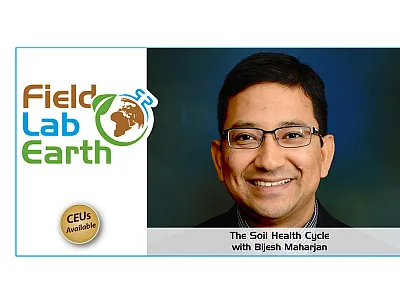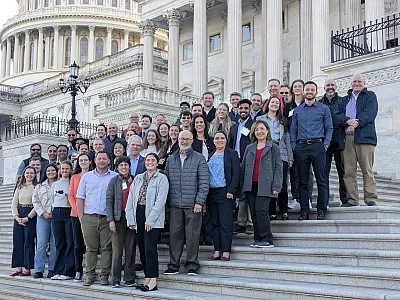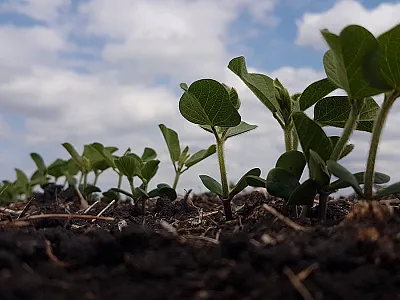Biosolids in the dryland Pacific Northwest seven years after application
Wheat yields, soil carbon, and nutrient availability continue to be enhanced


In the dryland region of inland Pacific Northwest (iPNW) the two-year winter wheat–fallow rotation is associated with wind erosion and a decline in soil organic carbon (SOC) and overall soil health. The use of biosolids, produced as by-products of municipal wastewater treatment, in agriculture is gaining traction as an effective way to improve SOC and nutrient availability. While immediate benefits of biosolids application have been studied to some extent, there is still a lack of research-based information on the persistence and residual effects of biosolids applications in the low-precipitation region of the iPNW. Therefore, a study was conducted to address that gap by assessing the legacy effects of biosolids, seven years after their application. Earn 0.5 CEUs in Soil & Water Management by reading this article and taking the quiz at https://web.sciencesocieties.org/Learning-Center/Courses.
In the dryland region of inland Pacific Northwest (iPNW), which receives limited precipitation (<14 inches a year), a two-year winter wheat–fallow rotation (WF) is the most common cropping system. In the WF system, land is left fallow for 13–14 months between two wheat crops for partial soil moisture recharge. The WF system often involves tillage during spring of the fallow period to minimize soil water evaporative loss during the hot, dry summer. Despite reliable wheat yields, the WF system is associated with wind erosion and a decline in soil organic carbon (SOC) and overall soil health. To help improve soil health, researchers are looking into adding organic materials like biosolids, biochar, and manure since moisture limits how much crop biomass can be produced. Additionally, conservation tillage (e.g., undercutter tillage, no-tillage, etc.) can help improve SOC, nutrient availability, and soil health as well as reduce erosion (Machado et al., 2006; Schillinger & Papendick, 2008).

Biosolids, produced as by-products of municipal wastewater treatment, are processed and tested to meet U.S. Environmental Protection Agency standards (USEPA, 1993). Their use in agriculture is gaining traction as an effective way to improve SOC and nutrient availability (Ippolito et al., 2021). Biosolids also improve soil health by boosting microbial activity and abundance, promoting nutrient cycling, improving soil water retention, and reducing soil erosion and compaction in wheat systems (Pi et al., 2018; Sullivan et al., 2009). While immediate benefits of biosolids application have been studied to some extent, there is still a lack of research-based information on the persistence and residual effects of biosolids applications, hereafter referred as “legacy effects,” in the low-precipitation region of the iPNW. Therefore, this study aims to address that gap by assessing the legacy effects of biosolids, seven years after their application.
Methodology
We conducted this study using existing biosolids field trials at the Washington State University’s Lind Dryland Research Station, which was set up in 2012 under a wheat–fallow cropping system (details found in Schillinger et al., (2022). Briefly, the study included two fertilizer (biosolids and synthetic N+S fertilizers) and two tillage (traditional tandem disk and conservation undercutter tillage) methods. Both tillage treatments were applied immediately after biosolids applications at 2.8 dry tons/acre (on dry weight basis to meet two wheat crop requirements) in mid-April of 2012 and 2016. Anaerobically digested and dewatered Class B biosolids were sourced from the King County, WA wastewater treatment plant. For synthetic fertilizer treatment, 50 lb N/ac and 10 lb S/ac were applied for each wheat crop as liquid aqua NH3–N and thiosol S, respectively. Synthetic fertilizers were injected at a 5-inch depth with the undercutter in late April. For the tandem disk treatment, synthetic N+S was stream-jetted on the soil surface and then immediately incorporated into the top 5 inches of the soil.
To assess the legacy effects of biosolids on crop yields, soft white winter wheat (cv. Devote) was planted 5 inches below the soil surface into moisture at a rate of 40 lb/ac using a deep-furrow drill with 16-inch row spacing in late August 2022. Prior to planting, the entire plot area, including biosolids and synthetic plots, was cultivated and fertilized with synthetic N+S fertilizer. Soil samples were taken from the top 4 inches of soils and tested for soil pH (1:1 soil:water), electrical conductivity (EC), NO3–N, NH4–N, P, K, Ca, Mg, Na, S, Zn, Fe, Mn, Cu, B, total soil C (TC by dry combustion method), and total soil N (TN by dry combustion method) at Soiltest Farm Consultants, Inc., Moses Lake, WA. Grain yields, spike density, 1000-grain weight, and straw production (biomass without grain) were measured from random 40-inch row sections in each plot. Grain protein was measured using a Perten DA7250 Grain Protein Analyzer (Perten Instruments Inc., Springfield, IL). Analysis of variance was conducted for all soil properties, yield components, grain yield, grain protein, and straw biomass in SAS v. 9.4 statistical package.
Biosolids’ legacy effects on soil properties and yield components
The legacy of fertilizer type (biosolids vs. synthetic N+S) had a stronger influence on the soil and crop responses than the tillage method (tandem disk vs. undercutter tillage). Even seven years after the last application of biosolids, soil nutrients such as soil P, S, Zn, Fe, Mn, and Cu were still higher (3.2, 1.6, 6.1, 1.6, 1.8, and 2.3-fold higher, respectively) compared with synthetic fertilizer (Table 1).
Table 1. Soil properties in the top 4 inches affected by tillage method (tandem disk vs. undercutter) and fertilizer type (biosolids vs. synthetic N+S) seven years after application of biosolids.
| Soil properties | Fertilizer treatments | |||
| Biosolids | Synthetic | |||
| ────────── % ────────── | ||||
| Total C | 1.15 a* | 0.75 b | ||
| Total N | 0.129 a | 0.093 b | ||
| ────────── ppm ────────── | ||||
| Soil P | 87.6 a | 27.3 b | ||
| Soil S | 8.87 a | 5.44 b | ||
| Soil Zn | 3.18 a | 0.525 b | ||
| Soil Fe | 55.3 a | 34.1 b | ||
| Soil Mn | 16.0 a | 8.69 b | ||
| Soil Cu | 2.06 a | 0.913 b | ||
| Soil Mg | 1.49 b | 1.68 a | ||
| Soil pH | 5.25 b | 5.7 a | ||
| Tillage treatments | ||||
| Disk | Undercut | |||
| Soil Mg (ppm) | 1.54 b | 1.63 a | ||
| Fertilizer × tillage treatments | ||||
Disk × biosolids | Disk × synthetic | Undercut × synthetic | Undercut × biosolids | |
| Total C (%) | 0.923 b | 0.728 b | 0.769 b | 1.37 a |
| Total N (%) | 0.106 b | 0.0913 b | 0.0094 b | 0.151 a |
| Soil K (ppm) | 930 ab | 889 b | 998 a | 958 ab |
*Means followed by small letters show significantly different means among treatments at p < 0.05 within a row.
Similarly, the effects of biosolids’ legacy were more pronounced on crop responses as spike density, grain yield, and straw production were 42, 42, and 47% higher, respectively, under biosolids. Although the 1000-grain weight was 8% higher under synthetic fertilizer, grain protein was similar between fertilizer types.

The long-term availability of soil nutrients from biosolids’ legacy is likely why grain yield, straw production, and spike density were higher compared with synthetic fertilizer. In the region, applications of P and micronutrients are uncommon due to high costs, and soils in this region are often depleted in these essential micronutrients (Schillinger et al., 2022). This study shows that even seven years after the last application, biosolids continue to supply both macro- and micro-nutrients, making them a cost-effective and long-lasting option for boosting soil nutrient availability in the iPNW drylands. For soft white wheat, a grain protein >10% is undesirable due to overseas market requirements. Increased grain protein due to biosolid application has been a concern in previous studies (Cogger et al., 2013; Sullivan et al., 2009); however, this was not observed in our study. Among interactions of tillage and fertilizer treatments, TC and TN followed the trend of undercutter with biosolids > undercutter with synthetic = disk with synthetic = disk with biosolids (Table 1). Increased TC can be explained by higher organic matter addition (Ippolito et al., 2021), less soil disturbance (Schillinger, 2001), reduced erosion (Pi et al., 2018), increased straw biomass (Schillinger et al., 2022), and more surface residue cover after 13 months of fallow under undercutter tillage (>32%) as compared with more intensive disk tillage (<25%) (Schillinger et al., 2022).
The higher straw biomass due to biosolids’ legacy is vital for the low-SOC, erosion-prone soils of the iPNW (Pi et al., 2018; Schlatter et al., 2019). Overall, biosolids improved nutrient availability, wheat grain yield, and yield components even seven years after the last application. This study suggests that periodic biosolids application can enhance soil nutrient availability, SOC, and grain yields in dryland wheat systems of the iPNW.
References
Cogger, C. G., Bary, A. I., Kennedy, A. C., & Fortuna, A.M. (2013a). Long-term crop and soil response to biosolids applications in dryland wheat. Journal of Environmental Quality, 42(6), 1872–1880. https://doi.org/10.2134/jeq2013.05.0109
Ippolito, J. A., Ducey, T. F., Diaz, K., & Barbarick, K. A. (2021). Long-term biosolids land application influences soil health. Science of the Total Environment, 791, 148344.
Machado, S., Rhinhart, K., & Petrie, S. (2006). Long‐term cropping system effects on carbon sequestration in eastern Oregon. Journal of Environmental Quality, 35(4), 1548–1553. https://doi.org/10.2134/jeq2005.0201
Pi, H., Sharratt, B., Schillinger, W. F., Bary, A. I., & Cogger, C. G. (2018). Wind erosion potential of a winter wheat–summer fallow rotation after land application of biosolids. Aeolian Research, 32, 53–59.
Schillinger, W. F. (2001). Minimum and delayed conservation tillage for wheat–fallow farming. Soil Science Society of America Journal, 65, 1203–1209. https://doi.org/10.2136/sssaj2001.6541203x
Schillinger, W. F., Cogger, C. G., & Bary, A. I. (2022). Biosolids and conservation tillage for rainfed wheat farming in dry Mediterranean climates. Soil and Tillage Research, 223, 105478.
Schillinger, W. F., & Papendick, R. I. (2008). Then and now: 125 years of dryland wheat farming in the Inland Pacific Northwest. Agronomy Journal, 100, S-166–S-182. https://doi.org/10.2134/agronj2007.0027c
Schlatter, D. C., Paul, N. C., Shah, D. H., Schillinger, W. F., Bary, A. I., Sharratt, B., & Paulitz, T. C. (2019). Biosolids and tillage practices influence soil bacterial communities in dryland wheat. Microbial Ecology, 78, 737–752.
Sullivan, D. M., Bary, A. I., Cogger, C. G., & Shearin, T. E. (2009). Predicting biosolids application rates for dryland wheat across a range of Northwest climate zones. Communications in Soil Science and Plant Analysis, 40(11–12), 1770–1789. https://doi.org/10.1080/00103620902896688
USEPA. 1993. USEPA federal standards for the use or disposal of sewage sludge; final rules. United States Environmental Protection Agency. https://www.epa.gov/sites/default/files/2020-02/documents/fr-2-19-1993-sewage-sludge.pdf
Self-study CEU quiz
Earn 0.5 CEUs in Soil & Water Management by taking the quiz for the article at https://web.sciencesocieties.org/Learning-Center/Courses. For your convenience, the quiz is printed below. The CEU can be purchased individually, or you can access as part of your Online Classroom Subscription.
1. The winter wheat–fallow rotation system
a. does not typically involve tillage.
b. typically involves land left fallow for 6 months between two wheat crops.
c. is not commonly used in the inland Pacific Northwest.
d. typically involves tillage during spring to minimize soil water loss during summer.
2. Which of the following was NOT mentioned in the article as a benefit of applying biosolids?
a. Improves soil organic carbon and boost microbial activity.
b. Reduces build up of heavy metals in the soil.
c. Reduces soil erosion and compaction.
d. Improves soil water retention.
3. What treatments were included in the study?
a. Biosolids and synthetic fertilizers, tillage and no tillage.
b. Biosolids and no biosolids, traditional tandem disk and conservation undercutter tillage.
c. Biosolids and no biosolids, tillage and no tillage.
d. Biosolids and synthetic fertilizers, traditional tandem disk and conservation undercutter tillage.
4. Grain yield was ___ higher under biosolids.
a. 42%
b. 45%
c. 47%
d. 8%
5. Increased grain protein due to biosolid application was observed in this study.
a. True.
b. False.
Text © . The authors. CC BY-NC-ND 4.0. Except where otherwise noted, images are subject to copyright. Any reuse without express permission from the copyright owner is prohibited.










